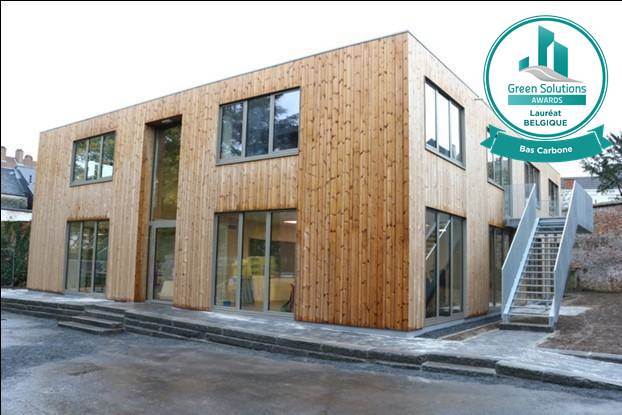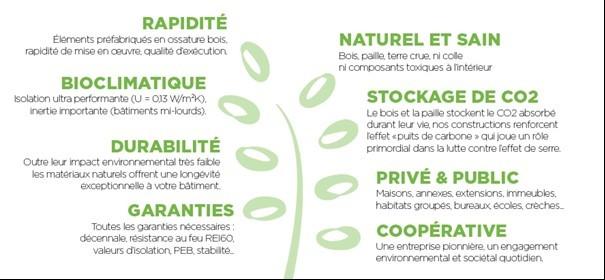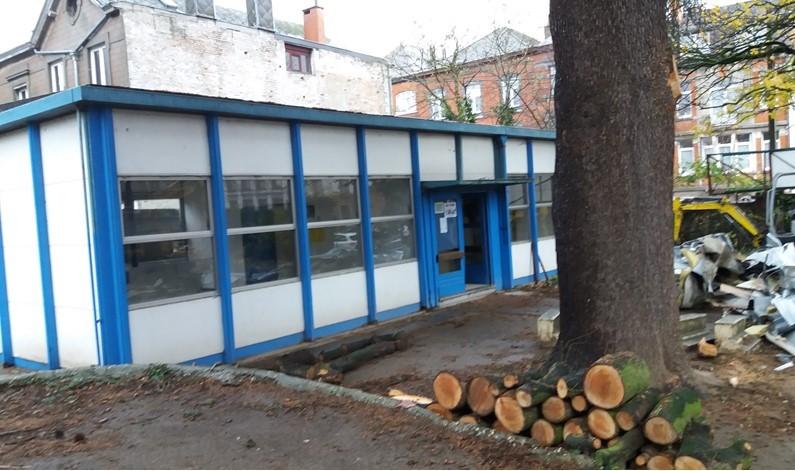College "Notre-Dame de Bon secours"
Last modified by the author on 28/03/2024 - 10:56
New Construction
- Building Type : School, college, university
- Construction Year : 2017
- Delivery year : 2018
- Address 1 - street : 7130 BINCHE, Belgique
- Climate zone : [Cfb] Marine Mild Winter, warm summer, no dry season.
- Net Floor Area : 1 000 m2
- Construction/refurbishment cost : 1 288 026 €
- Number of Pupil : 13 Pupil
- Cost/m2 : 1288.03 €/m2
-
Primary energy need
74 kWhep/m2.an
(Calculation method : Other )
Since the start of All Saints' Day 2017, students in Secondary 5 and 6 of the College "Notre-Dame de bon secours" in Binche are the first in Belgium to take classes in a building isolated with straw and wooden frame. A spacious, bright, and healthy pavilion has replaced a prefabricated sheet metal energy wastage. This pavilion is the first prefabricated school building made of wood, compressed straw and clay plaster in French-speaking Belgium.
In 2014, the management of college "Notre-Dame de Bon secours " in Binche, in the Walloon Region, wanted to set an example in order to be in full coherence with the applied pedagogy of the establishment defending respect for the environment and of eco-citizenship.
Also after much research and after being surrounded by "specialists", she made the choice of a passive construction with materials mainly of plant origin. Thus, the construction system of the college which was built by De Graeve, a subsidiary of Eiffage Construction Benelux and specialist in passive constructions, combines three renewable materials: wood for structural work, straw for walls, earth. In addition, the roof is cork insulated, as the clay coating for the interior lining.
This college uses each subject in a reasoned way to make the most of it and avoids wasting all the gray energies. Building with natural materials made it possible to build buildings with a negative carbon footprint. Being of vegetable origin, the wood and the straw are fixers of C02. The choice of materials has been designed to promote a supply via sectors as short as possible.
This construction is designed to last, the care taken in its implementation offers a long life to the building; in addition, if we decide to dismantle them one day, the materials will be almost completely compostable. The interior comfort is also optimized thanks to the absence of volatile substances (VOC) and thanks to the hygrometric regulation properties of the earth coatings. The straw bale walls offer sound insulation qualities.
Building users opinion
Building with natural materials makes it possible to build buildings with a negative carbon footprint. This construction is designed to last, the care taken in its implementation offers a long life to the building but if we decide one day to dismantle them, they are almost completely compostable
This type of construction removes CO2 from the atmosphere since it allows to store a significant amount as long as the construction is standing.
For comparison, building conventionally generates additional CO 2 in the atmosphere, because of the nature of the materials used often from petrochemicals and the energy it took to industrially manufacture them.
Moreover, no indoor pollution of the ambient air.
Use of solid wood, untreated. Floors and partitions are counter-nailed (rather than bonded) and all insulators used are completely sanitary neutral.
In addition, straw bale walls also have acoustic insulation qualities.
The site was treated with a result in "blowerdoortest" better than the threshold set for a passive construction.
If you had to do it again?
This project was not an easy task:
1. the legend of the 3 little pigs and the prejudices related to it are still very much present in the collective unconscious; straw construction is still too much considered today as an alternative or even marginal vision of the possibilities of building (but we informed and convinced);
2. Finding the architect with a big A was not easy (but we got there);
3.Straw building is still a pioneering step that has not given us the comfort of relying on the experience of other establishments;
4.The heaviness and slowness of all administrative procedures: we encourage us to engage in passive or positive constructions but no administrative or financial support is offered.
See more details about this project
https://www.cndbs-binche.be/drupal/constructionPavillonhttp://www.pailletech.be/binche/
http://degraeve.be/project/college-notre-dame-du-bon-secours/
Data reliability
Self-declared
Contractor
Construction Manager
Stakeholders
Designer
AAIA - Atelier Alter Ingénieurs et Architectes
Christophe Lootvoet - [email protected]
http://www.aaia.be/Environmental consultancy
EURECA et A+ Concept
Matthieu Bourgeois - [email protected]
http://eureca-net.be/Economy and rational use of energy, advice and support
Contracting method
General Contractor
https://www.construction21.org/belgique/data/sources/users/1917/gdg-ca-eblx-29-mars-20181.pptxOwner approach of sustainability
For several years, the College "Notre-Dame of Bon Secours" of Binche is invested
in the sustainable development, with an "Eco-Team" which carries out several projects to make the students aware of the environment and the eco-citizenship. In order to be in full coherence
with the pedagogy applied in the establishment, the direction of the college wanted
- to set an example for future adults by choosing a positive construction with materials predominantly of plant origin;
- provide students and teachers with a healthy work environment.
"We wanted to make the values of our Eco-Team a strong gesture," says Teresa Maggiordomo, director of the school. The board quickly approved the project, the expense being not much higher than a more traditional solution. "We are at 1250 € / m² gross, which remains competitive," says Jean-Michel de Marchi, deputy director.The first building has eight classes, the second building five classrooms, a laboratory and sanitary facilities. However, the client had to show determination because he had to overcome many obstacles:
- the legend of the three little pigs and the prejudices related to it are still very much present in the collective unconscious; straw construction is still too much considered today as an alternative or even marginal vision of the possibilities of building;
- to find the architect with a large A was not easy;
- building a straw is still a pioneering process that does not allow to rely on the experience of other institutions;
- the cumbersome and sluggishness of all the administrative procedures has slowed the realization: "we encourage us to engage in passive or positive constructions but no administrative or financial support is offered", Teresa Maggiordomo laments
Architectural description
Since start of All Saints' Day 2017, 5th and 6th grade students at the" Notre-Dame de Bon Secours" secondary school in Binche are the first in Belgium to take classes in a building isolated from straw and timber framing. A spacious, bright, and healthy pavilion has replaced a prefabricated sheet metal energy wastage. This pavilion is the first prefabricated school building made of wood, compressed straw and clay plaster in French-speaking Belgium.
This construction technique offers many advantages. The structural work consists exclusively of wood, straw and earth, which is renewable materials. The other materials are as natural as possible: the new pavilion has no concrete slab for example, but a cork insulation and a dry screed.
" We value environmentally friendly, unprocessed and healthy materials, thus ensuring recyclability of the building ", explains Christophe Lootvoet, architect of the project. While construction waste is being upgraded at a high cost, the pavilion can be almost completely compostable if it ever needs to be dismantled.
Second advantage: the exemplary carbon footprint. " To build a conventional passive building, a C02 peak is produced before and during construction " due in particular to the use of petrochemical materials. " We are storing CO2, which is much more interesting, " continues Christophe Lootvoet. Because being of vegetable origin, the wood and the straw are fixers of CO2 and make it possible to reach a negative carbon balance.
Third advantage of natural materials: indoor pollution is avoided. " Endocrine disruptors are present in a lot of materials. Even if they meet the standards, when you accumulate phthalates that release vinyls, paintings on the walls and ceiling, you do not live in a healthy environment . "
Another advantage: humidity is regulated by the clay coating on the walls. " With walls covered with plaster and latex paint, the humidity of the air varies greatly with condensation problems in the key. Here, we are dealing with a large exchange surface material, full of micropores, which allows a very constant humidity level. "
The project began in June 2017. The panels were transported from the workshops of the Paille-Tech cooperative to Franière (Floreffe), and assembled in Binche. " We used techniques from self-construction, with all the alternative aspect that implies, " says Antoine Bonnert, manager of Paille-Tech.
Energy consumption
- 74,00 kWhep/m2.an
- 125,00 kWhep/m2.an
- 125,00 kWhef/m2.an
Real final energy consumption
2 019
Envelope performance
- 0,12 W.m-2.K-1
- 0,40
- 0,51
Systems
- Condensing gas boiler
- Gas boiler
- No cooling system
- Double flow heat exchanger
- No renewable energy systems
Smart Building
Urban environment
- 5 000,00 m2
- 20,00 %
- 4 000,00
Product
Insulation of straw and clay walls
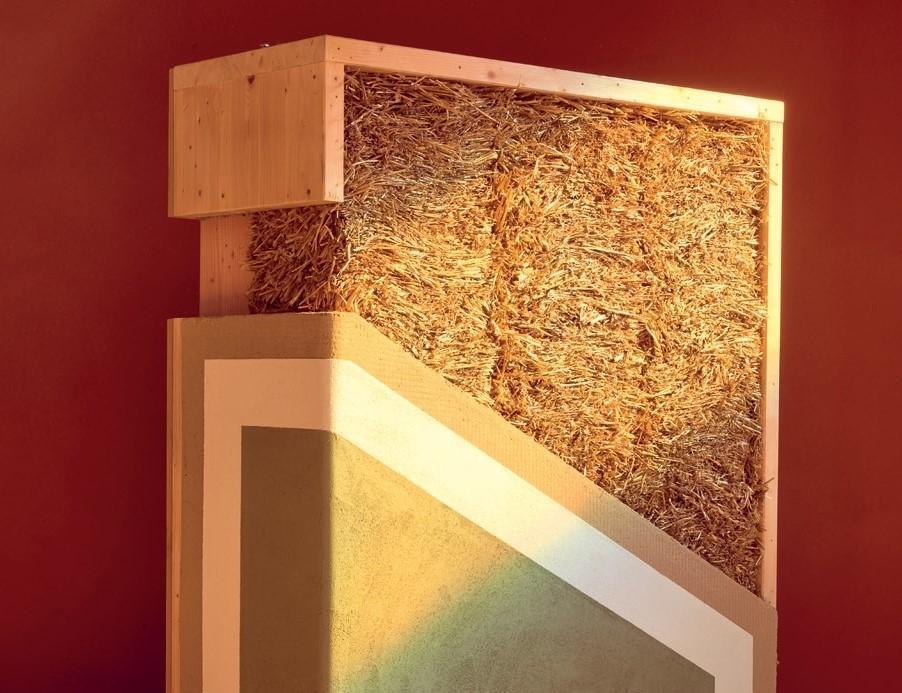
Pailletech
Paille-Tech scrl Rue de la Glacerie, 6 B-5150 Franière Belgique Tél : +32.(0)81.44.07.39 TVA : BE 0820.755.996
http://www.pailletech.be/Structural work / Passive system
Constructive system that uses straw as insulation and clay plaster for interior lining.
Straw construction is still too much considered today as an alternative or even marginal vision of the possibilities of building, but the contracting authoritiy managed to convince.
Expanded cork
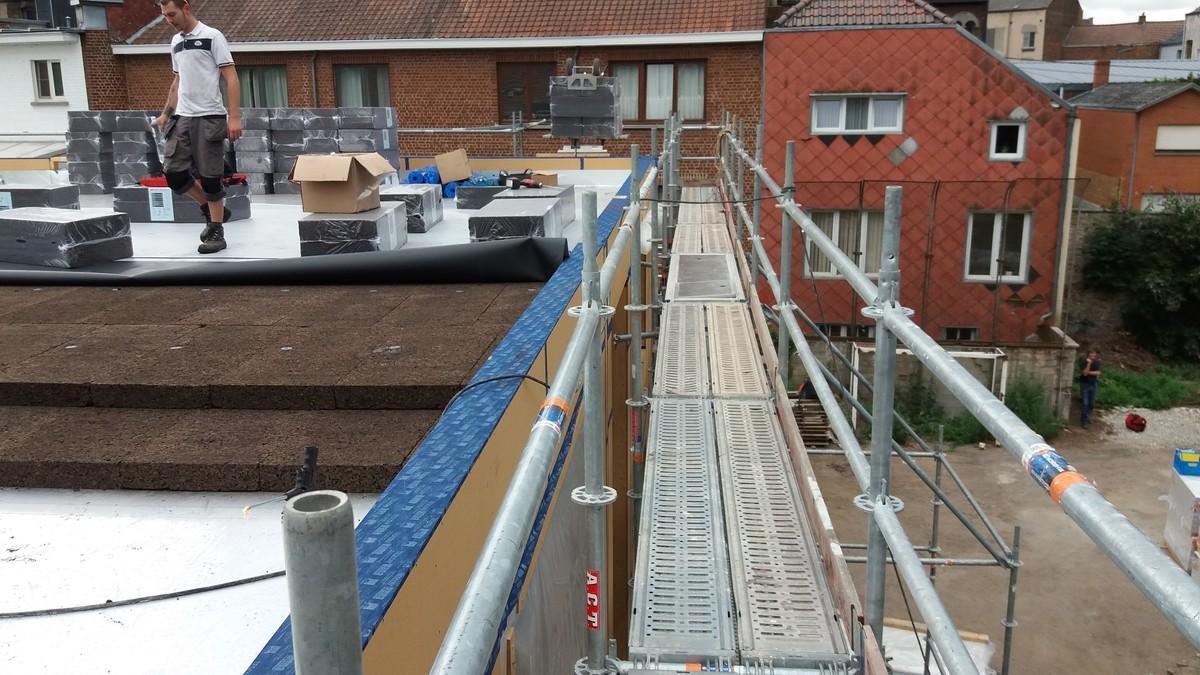
Qualicork
http://www.qualycork.beFinishing work / Partitions, insulation
Use for the floor and roof of cork and rubber.
No specific problem. High performance insulation: U = 0.13 W / m2K
Construction and exploitation costs
- 1 288 026 €
Comfort
GHG emissions
- 22,75 KgCO2/m2/an
- 100,00 an(s)
Reasons for participating in the competition(s)
Le collège Notre-Dame de bon secours de Binche est une construction positive qui utilise chaque matière de manière raisonnée pour en tirer le meilleur parti et évite de gaspiller toutes les énergies grises. Construire avec des matériaux naturels a permis de réaliser des bâtiments avec un bilan Carbone négatif. Étant d’origine végétale, le bois et la paille sont des fixateurs de C02.
Dans une approche de responsabilité sociétale, l’entreprise De Graeve qui a réalisé le bâtiment, créée en 1965 et établie à Beez depuis 1985, a développé depuis 2008 une expertise dans la réalisation de bâtiments passifs en ossature bois ou en « massif-passif ».
Ces projets, hautement techniques mobilisent tant le savoir-faire que la créativité des équipes. Nouvelles technologies, nouveaux matériaux, soin très particulier à apporter lors de l’exécution sont autant de sujets de réflexion sur lesquels De Graeve travaille avec ses partenaires.
Plusieurs chantiers sont à son actif : la première école maternelle passive de la communauté française, 50 logements passifs pour étudiants pour l’UCL, une crèche passive en ossature bois à La Louvière et l’antenne communale d’Ottignies à Louvain- la-Neuve (1500 m² de bureaux passifs). Un ensemble de 14 appartements sociaux passifs construits sur quatre étages en ossature bois, projet exceptionnel, a été primé de nombreuses fois, notamment par le «Blue House» 2012 de la Fondation pour les Générations Futures (prix pour une construction durable et abordable). De Graeve est membre de la « plateforme Maisons passives » et du cluster CAP2020.
Building candidate in the category

Energy & Temperate Climates

Low Carbon

Health & Comfort





